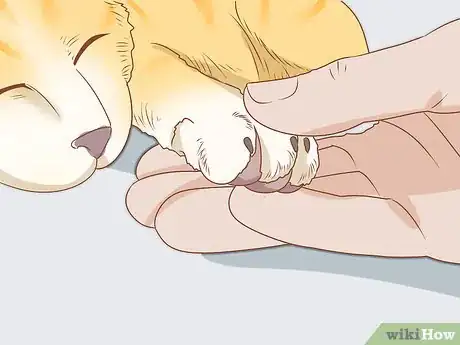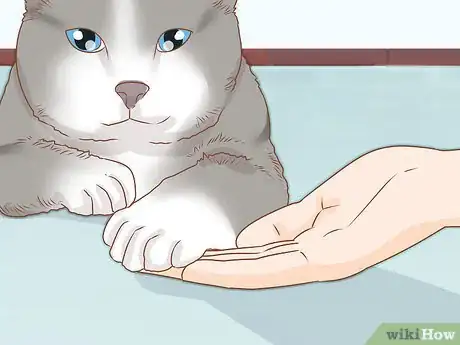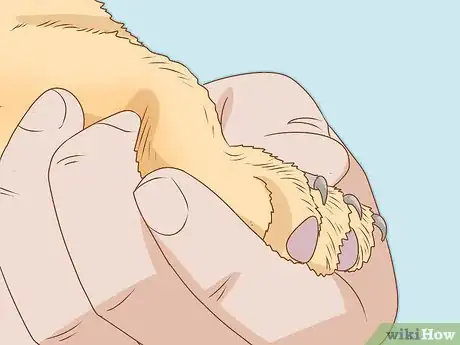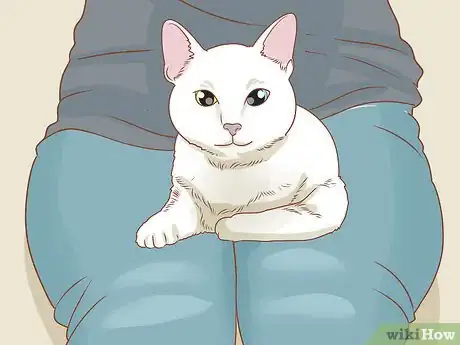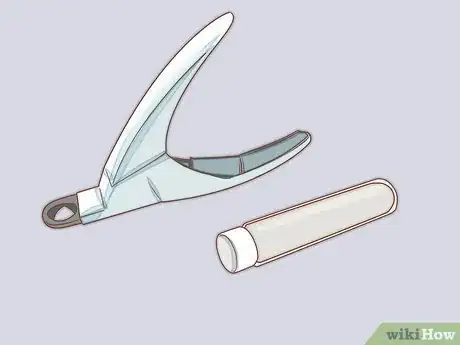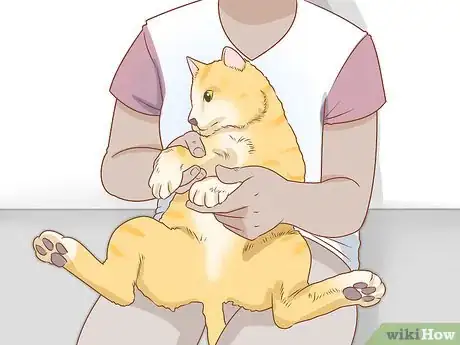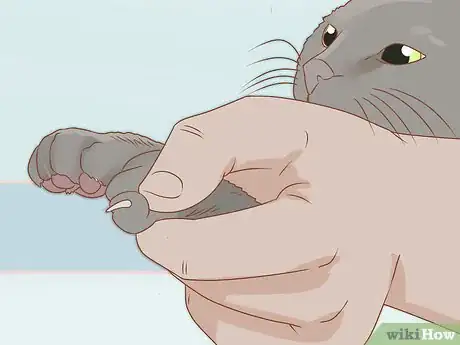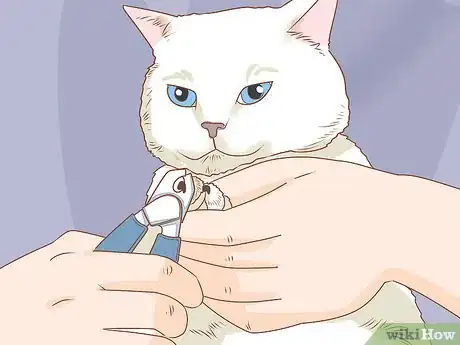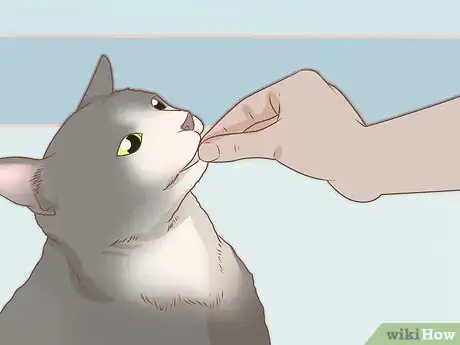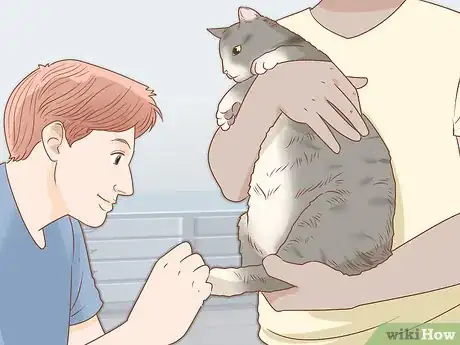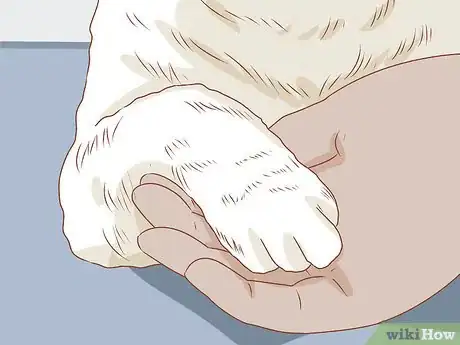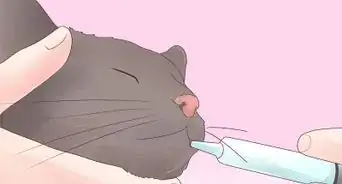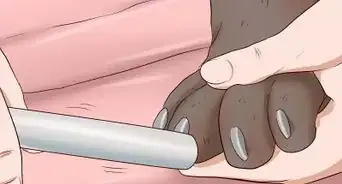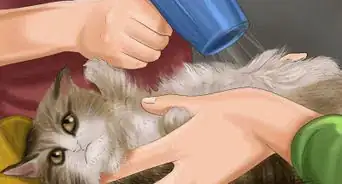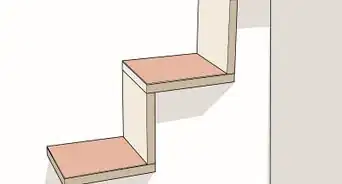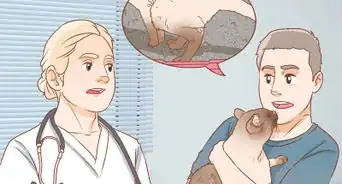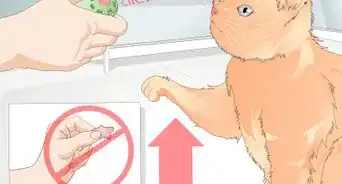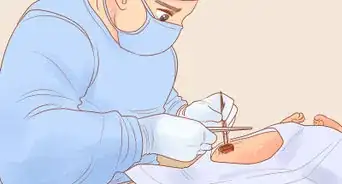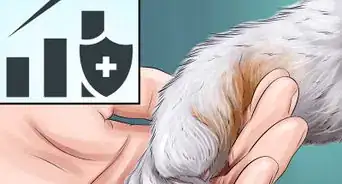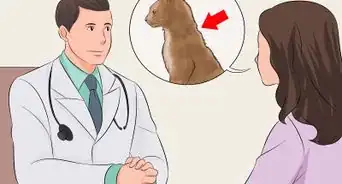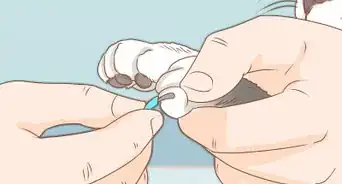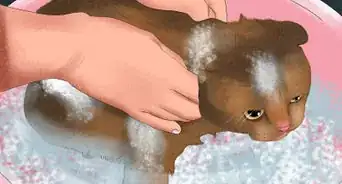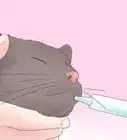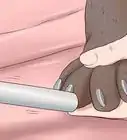This article was co-authored by Pippa Elliott, MRCVS. Dr. Elliott, BVMS, MRCVS is a veterinarian with over 30 years of experience in veterinary surgery and companion animal practice. She graduated from the University of Glasgow in 1987 with a degree in veterinary medicine and surgery. She has worked at the same animal clinic in her hometown for over 20 years.
wikiHow marks an article as reader-approved once it receives enough positive feedback. This article received 16 testimonials and 100% of readers who voted found it helpful, earning it our reader-approved status.
This article has been viewed 1,176,606 times.
A cat may need its nails trimmed to keep them from splitting or breaking, and you may find it productive to trim off the sharp points of your cat’s nails if the cat is prone to kneading, scratching, etc. Trimming a cat’s nails is fairly easy once you get your cat accustomed to it. Read on for detailed instructions.
Steps
Preparing Your Cat
-
1Pet your cat’s paws. Most cats are naturally a little skittish about having their paws handled, so begin by helping your cat get accustomed to it.[1]
- Wait for a time when your cat is relaxed and lounging.
- Begin gently petting its paws while simultaneously petting the cat in its favorite spots (the back of the neck, under the chin, where its back meets its tail, etc.).
- Do this for each paw you plan to trim.
- The cat might pull its paws away, or even get up and walk away. Let it go; don't force it to do anything, but continue to gently pet its paws when you have the opportunity.
- Whenever you handle your cat’s paws, reward it with treats and praise to help build positive associations.
-
2Hold your cat’s paws. Once your cat is comfortable enough to allow you to rest your hand on its paws without pulling away, start to gently hold its paws in your open hand.
- Place your hand over the cat’s paw, then flip your hand around so the bottom of the cat's paw is on the palm of your hand.
- Keep rewarding the cat with petting and treats; give the cat a new, special treat that will only be associated with cutting its claws.
Advertisement -
3Massage your cat’s paws. After your cat grows accustomed to you holding its paws, start holding the paws and massaging them with your fingers.[2]
- Gently massage your fingers over the tops and bottoms of each paw you plan to trim.
- Reward your cat with more treats and praise.
-
4Look closely at your cat’s nails. Eventually, you should be able to gently squeeze the paws (applying most of the pressure on the pads) to push individual claws out without upsetting your cat.[3]
- When your cat’s claws are extended, you’ll see the thick part of the nail, and, towards the cat’s toe, a pinkish area inside the nail, called the quick.
- The quick is the living part of the nail and contains blood vessels and nerves, so cutting a cat’s nail to the quick is quite painful for the cat. Never cut a cat's nail close to or with flush with the toe; your aim is to clip off only the sharp point.[4]
- Look carefully at where and how large each quick is--through a clear nail it will look like a small pink triangle. Each of your cat’s nails will be similar, so even if the cat has dark nails, look to find one clear nail as a reference point for the others.
-
5Get your cat comfortable with the “nail-trimming position.” If your cat is already comfortable sitting in the right position to have its nails cut, it will put up less of a fight during the actual trimming.
- If you're going to be trimming the cat's nails by yourself, the cat will need to sit on its rear on your lap, facing away from you, while you hold its paw with one hand (and, eventually, the clippers with the other).
- Practice having your cat sit this way and hold each of its paws. Gently press on each nail to extend it. Again, reward the cat with treats and praise.[5]
- If you have someone to help, they can hold the cat facing you, or they can cradle it, while you hold the paw with one hand (and, eventually, clip with the other).
- Practice having your assistant hold your cat while you hold each of its paws and gently press each claw until your cat seems comfortable. Reward it with treats and praise.
Trimming a Cat’s Nails by Yourself
-
1Wait for the right opportunity. You can't trim your cat’s nails whenever you feel like it. You should pick a time when your cat is feeling nice and relaxed, such as when it's just coming out of a nap, getting ready to nap, or calmly resting on its favorite surface during the day.[6]
- Another good time for nail trimming is after your cat has eaten and is feeling sleepy and content.
- Don't try to trim your cat's nails right after play time, when it’s hungry, when it's restless and running around, or in an otherwise aggressive mood. The cat will be far from receptive to you trimming its nails.
- You may see that your cat has a broken or splitting nail and will want to cut it instantly, but don’t. Make a note of it and wait for your cat to get relaxed before trying to cut it, or you could make it worse.
-
2Use the right tools. Before sitting down to cut your cat’s nails, be sure you have the right equipment to do so. To trim your cat's nails, you’ll need a pair of nail clippers designed to clip cat claws and a styptic pencil.[7]
- There are several different styles of nail clippers, all of which largely do the same job. The most important thing is that the clippers are sharp, so they snip straight through the claw. Not only will using dull clippers make the job longer and harder, but you may also end up squeezing the quick, which can be painful for the cat. There are two primary styles of clipper: scissor and guillotine clippers.
- Scissor clippers cut a cat’s nails using a scissor motion and usually come in small and large sizes. The small “nippers” tend to be better for those new to clipping nails or if you just need to snip the tips. Larger scissor clippers are suited to cutting older, tougher nails.
- Guillotine clippers use a sliding blade that cuts the nail when you squeeze the handles together. The claw fits into a slot and the blade slides across to clip the nail. These are strong clippers that are good for cutting long, thick nails (but not overgrown nails--large clippers are better suited to that).
- If the clippers are sharp the cat won't feel the quick clip. Clippers don't stay sharp forever, so discard them (or send them for sharpening) if you suspect the blades have gone dull. Signs of this include having to apply a lot of pressure to cut the nail or the nail being “chewed” by the clippers rather than making a clean cut.
- Also have a styptic pencil on hand in case you cut the cat’s quick (which is less likely with a cat than a dog, as the cat's quick is much shorter). Styptic pencils are readily available from pharmacies (typically in the shaving section). They cauterize blood vessels when touched to the nail and help prevent bleeding. If you cut the quick, you can hold the styptic pencil to the claw for 1 - 2 minutes and the bleeding should stop.
-
3
-
4Find the place where the nail separates from the quick. Be sure you know where the quick is before you attempt to cut the nail--the quick will look like a small, pinkish triangle inside the nail.
- You should first cut just the tip of the nails, and as you get more comfortable, you can cut closer to the quick, but never cut all the way to the quick or you can hurt your cat and make its nails bleed.
-
5Cut the nails with the trimmers. Hold the cat as described earlier and cut the nails one by one. Position the trimmers halfway between the end of the quick and the claw.
- Try to orient the clippers so that when the nail is cut, the blade cuts from bottom to top. This will help prevent splitting.
- Try to avoid getting frustrated. Your cat may protest, meow, and try to scratch you, but don't yell at your cat or rush through the process, or you may end up hurting it and scaring it away having its nails trimmed again.
- You may only be able to trim one or two nails at a time at first.
-
6Give your cat a treat. It’s been a good sport about letting you cut its nails and should be rewarded for enduring it.
- Make the treat special: vacuum-packed salmon, or chicken. Some cats also like sour cream or butter.
- Using a special treat ensures that your cat begins to associate this treat with getting its nails trimmed. So though your cat may not love the nail-trimming part, it'll want the treat afterwards, so it'll be less resistant in the future.
-
7Check your cat's nails regularly. Each cat's nails grow at a different rate, but it's a good rule of thumb to trim your cat's nails somewhere between every two weeks and every month so that its nails don't get too long, split, or break.
- Though your cat will be sharpening its claws and keeping them in good shape on its own, keep an eye on their nails nonetheless. Your cat could be walking around with a broken nail, and you can help it out by trimming it into shape.
- Older cats need special attention because their nails are thicker and can sometimes press around into the pads, cutting into them. Check your older cat's nails every week and clip the tip off if necessary. This is much easier than letting the nails get overgrown, which can cause them to impact into the pads. If this happens, the cat will need to see a veterinarian because antibiotics may be necessary.[10]
Trimming Your Cat’s Nails with Help
-
1Choose a person your cat knows and trusts. Don't get a stranger or relative stranger to help you trim your cat's nails or your cat will be even more scared.
- Though it sounds good and fine to get your cat used to having its nails trimmed, the reality is, many cats will still protest every single time, and you may have to get some extra help to do it.
-
2Have your helper hold the cat in place. You can both try standing on opposite sides of a raised surface, like a counter.
- Both of you should talk calmly and reassuringly to the cat.
- Have your helper pet the cat and try to keep it in place by holding on to its body without hurting it or scaring it too much.
- If your cat enjoys being brushed, the other person can brush the cat to distract it from the fact that it's getting its nails trimmed. Have your helper brush the cat’s head, under its neck, or in other places where it enjoys being brushed.
-
3Hold one of your cat's paws in your hand. While holding the paw, push down on the pad to extend the claws.
- If your cat is being rowdy, wait for it to settle down so that you can isolate the paw.
-
4Trim your cat's nails as you normally would. Your helper will continue to distract the cat while you trim its claws.
- Just follow the directions in the previous section to make sure you give your cat a smooth, painless nail trim.
- When you're done, reward your cat with a nice treat.
-
5Check your cat's nails on a regular basis. Every cat's nails will grow at a different rate, but it's good practice to trim your cat's nails somewhere between every two weeks and every month so that its nails don't get too long, split, or break.
- Though your cat will likely sharpen its claws and keep them in good shape on its own, keep an eye on its nails nonetheless. Your cat could be walking around with a broken nail, and you can help it out by trimming it into shape.
- Older cats need special attention because their nails are thicker and can sometimes press around into the pads and cut into them. Check your older cat's nails every week, and clip the tip off if necessary. This is much easier than letting the nails get overgrown, which can cause them to impact into the pads. If this happens then the cat will need to see a veterinarian because antibiotics may be necessary.[11]
Expert Q&A
Did you know you can get expert answers for this article?
Unlock expert answers by supporting wikiHow
-
QuestionMy cat's nail peel, with paper thin pieces coming away. The is no bleeding, pain or swelling. Is this normal?
 Pippa Elliott, MRCVSDr. Elliott, BVMS, MRCVS is a veterinarian with over 30 years of experience in veterinary surgery and companion animal practice. She graduated from the University of Glasgow in 1987 with a degree in veterinary medicine and surgery. She has worked at the same animal clinic in her hometown for over 20 years.
Pippa Elliott, MRCVSDr. Elliott, BVMS, MRCVS is a veterinarian with over 30 years of experience in veterinary surgery and companion animal practice. She graduated from the University of Glasgow in 1987 with a degree in veterinary medicine and surgery. She has worked at the same animal clinic in her hometown for over 20 years.
Veterinarian Yes, this is normal. A cat's claws are different from human fingernails or a dog's claws, in that the nail grows in layers a bit like the skins on an onion. Therefore it's common for the outer layer to peel away, especially if it's slightly damaged during scratching. This is an adaptation that leaves the cat with a permanently sharp set of nails for climbing or fighting.
Yes, this is normal. A cat's claws are different from human fingernails or a dog's claws, in that the nail grows in layers a bit like the skins on an onion. Therefore it's common for the outer layer to peel away, especially if it's slightly damaged during scratching. This is an adaptation that leaves the cat with a permanently sharp set of nails for climbing or fighting. -
QuestionDo you need to trim the cat's back paw claws?
 Pippa Elliott, MRCVSDr. Elliott, BVMS, MRCVS is a veterinarian with over 30 years of experience in veterinary surgery and companion animal practice. She graduated from the University of Glasgow in 1987 with a degree in veterinary medicine and surgery. She has worked at the same animal clinic in her hometown for over 20 years.
Pippa Elliott, MRCVSDr. Elliott, BVMS, MRCVS is a veterinarian with over 30 years of experience in veterinary surgery and companion animal practice. She graduated from the University of Glasgow in 1987 with a degree in veterinary medicine and surgery. She has worked at the same animal clinic in her hometown for over 20 years.
Veterinarian
Warnings
- Do not use nail clippers or scissors made for humans. It splits the cat's nails.⧼thumbs_response⧽
- Be very careful not to cut too far back and hit the quick. It is very painful for the cat.[13]⧼thumbs_response⧽
- The ASPCA strongly discourages “declawing” a cat, which can cause nerve damage as well as emotional distress in a cat. Instead, trim a cat’s claws every few weeks and provide scratching posts or surfaces.[14]⧼thumbs_response⧽
References
- ↑ http://www.aspca.org/pet-care/virtual-pet-behaviorist/cat-behavior/trimming-your-cats-claws
- ↑ http://www.aspca.org/pet-care/virtual-pet-behaviorist/cat-behavior/trimming-your-cats-claws
- ↑ Jones Animal Nursing. Jones. Publisher: Pergamon.
- ↑ http://pets.webmd.com/cats/guide/cat-nail-clipping-care
- ↑ http://pets.webmd.com/cats/guide/cat-nail-clipping-care
- ↑ http://pets.webmd.com/cats/guide/cat-nail-clipping-care
- ↑ http://www.aspca.org/pet-care/virtual-pet-behaviorist/cat-behavior/trimming-your-cats-claws
- ↑ http://pets.webmd.com/cats/guide/cat-nail-clipping-care
- ↑ http://www.humanesociety.org/animals/cats/tips/trimming_cat_claws.html
- ↑ Jones Animal Nursing. Jones. Publisher: Pergamon.
- ↑ Jones Animal Nursing. Jones. Publisher: Pergamon.
- ↑ Jones Animal Nursing. Jones. Publisher: Pergamon.
- ↑ http://pets.webmd.com/cats/guide/cat-nail-clipping-care
- ↑ http://pets.webmd.com/cats/guide/cat-nail-clipping-care
About This Article
To trim your cat's nails, sit the cat on its rear in your lap, facing away from you, and pick up one of its paws. Massage the paw, then press down gently to expose the claws. Position the trimmers halfway between the quick and the claw, then squeeze the trimmers to clip off the nail. Work on one nail at a time, then switch to the next paw. Always follow up your trimming sessions by giving your cat a tasty treat! To learn about trimming your cat's nails when you have a helper with you, read on!
